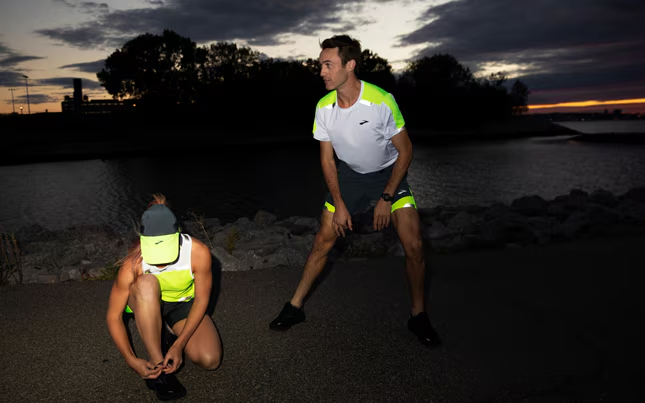Running at night can be a peaceful and invigorating experience, offering cooler temperatures and a break from the day’s hustle. However, running after dark comes with its own set of safety challenges. Reduced visibility, less pedestrian traffic, and the possibility of encountering hazards make it crucial to take extra precautions. By following the right safety measures, you can enjoy your nighttime runs while minimizing risks. In this post, we’ll cover key tips for staying safe and secure while running at night.

1. Wear Reflective Gear
One of the most important aspects of running safely at night is ensuring you are visible to others. Whether you’re running on roads, trails, or in urban areas, visibility is key to avoiding accidents with vehicles, cyclists, or other runners.
Reflective Clothing and Gear:
- Reflective vests or jackets: These garments are designed to make you visible from all angles. Wearing them ensures that headlights can easily spot you from a distance.
- Reflective bands or armbands: If you don’t want to invest in a full reflective vest, consider wearing reflective bands on your arms and legs. These simple additions improve your visibility, especially in low light.
- LED lights: Clip-on LED lights or headlamps are an excellent addition to your running gear. A headlamp illuminates your path and makes you visible to others.
- Bright clothing: Opt for bright-colored clothes, such as neon yellow, pink, or orange. These colors are more visible than dark clothing, especially when illuminated by streetlights or car headlights.
By wearing reflective gear, you’ll ensure that drivers and other pedestrians see you, which significantly reduces your risk of accidents.
2. Choose Well-Lit Routes
When running at night, the route you choose is crucial for safety. Avoid poorly lit areas or places with minimal foot traffic, as these can pose both visibility and security risks.
Tips for Safe Routes:
- Stick to well-lit streets: Run along roads with streetlights and in areas where you feel comfortable. Well-lit roads are not only safer but also provide peace of mind knowing that others can easily see you.
- Familiarize yourself with the route: If you’re running in a new area, make sure you’re familiar with the layout and any potential hazards, such as uneven sidewalks or busy intersections.
- Avoid isolated areas: If possible, avoid running through parks, trails, or deserted streets. These areas can feel unsafe at night and increase the risk of encountering potential dangers.
By planning your route carefully, you can minimize risks and enjoy a safer, more pleasant run.
3. Use Technology to Stay Safe
In today’s world, there are several technological tools that can help you stay safe while running at night. From tracking your location to ensuring you have quick access to emergency contacts, technology can be a valuable tool for nighttime runners.
Safety Apps and Gadgets:
- Run tracking apps: Apps like Strava or RunKeeper allow you to track your route, pace, and distance. Some apps even have real-time sharing features so you can share your run with a trusted friend or family member.
- Emergency alert apps: Some apps, such as Road ID or bSafe, send notifications to designated contacts if you feel unsafe or if there’s a significant change in your activity, such as a sudden stop or fall.
- Smartwatches or fitness trackers: Many smartwatches, like the Apple Watch or Garmin, include safety features like fall detection and emergency SOS. These devices can quickly notify emergency services or contacts if you need help.
Leveraging these tools ensures that you have an added layer of protection and can get help quickly if needed.
4. Stay Aware of Your Surroundings
One of the most important safety tips for running at night is to stay alert and aware of your surroundings. At night, it can be easier to become distracted, but paying attention to what’s around you can prevent accidents and help you avoid potential dangers.
Tips for Staying Aware:
- Limit distractions: Avoid wearing headphones or earbuds when running at night, as they can prevent you from hearing traffic, approaching cyclists, or other important sounds in your environment.
- Be cautious at intersections: Always stop and check for oncoming traffic before crossing intersections, even if you have the right of way. At night, vehicles may have a harder time spotting you.
- Run with a buddy: If possible, run with a friend or family member. Running in pairs or groups provides added security and ensures someone is nearby if an emergency arises.
Run, Relax & Recharge
At Garioch Road Runners, we welcome runners of all abilities to join our weekly sessions in and around Inverurie, Aberdeenshire. Whether you’re training for a race or enjoying a social run, we offer a supportive environment for everyone. After a fulfilling run, some members choose to unwind with light entertainment options like jackpotjillvip Casino Login. We believe in balancing physical activity with moments of relaxation to maintain overall well-being.
Remaining vigilant helps you react quickly to any potential hazards that might arise during your run.
5. Carry Identification and Emergency Contact Information
In case of an emergency, it’s crucial to have identification and emergency contact details with you during your nighttime runs.
What to Carry:
- ID bracelet or necklace: A simple ID bracelet or necklace with your name, contact number, and any necessary medical information can be a lifesaver if something goes wrong.
- Phone: Always carry a fully charged phone with you. It’s essential for emergency situations and will allow you to contact someone in case of an emergency.
- Medical info: If you have any medical conditions (e.g., allergies, diabetes), carry a card or note that provides relevant information for first responders.
Having this information on hand ensures that you’re prepared if something unexpected happens during your run.
6. Run with Self-Defense in Mind
While the risk of encountering danger while running at night is low, it’s always wise to be prepared. Running in unfamiliar areas or at odd hours can sometimes present security risks, so it’s important to take precautions.
Self-Defense Tools:
- Pepper spray or personal alarms: Carrying a small can of pepper spray or a personal alarm can be a quick way to defend yourself in an emergency.
- Self-defense classes: Taking a self-defense class can give you the confidence and skills to protect yourself if needed.
- Trust your instincts: If something doesn’t feel right, trust your gut and find a safe area to stop and reassess the situation.
By being prepared, you can feel more secure during your nighttime runs and handle any potential threats more effectively.
Beyond the Finish Line: Exploring Digital Entertainment
Garioch Roadrunners embodies the spirit of endurance and community in running. After pushing physical limits and achieving personal bests, many athletes also enjoy unwinding with various forms of online entertainment. For those interested in exploring reputable digital gaming platforms, searching for casinos new zealand can lead to engaging experiences. Always remember to balance your athletic pursuits with responsible and enjoyable digital leisure activities.
Conclusion
Running at night can be a rewarding experience, offering a quiet and serene environment for your workout. However, it’s essential to prioritize safety to ensure that your runs are enjoyable and risk-free. By following these tips—wearing reflective gear, choosing well-lit routes, using technology, staying aware of your surroundings, carrying identification, and taking self-defense precautions—you can run at night with confidence and peace of mind. Remember, safety is key, and a few simple steps can make all the difference in protecting yourself while enjoying your nighttime runs











